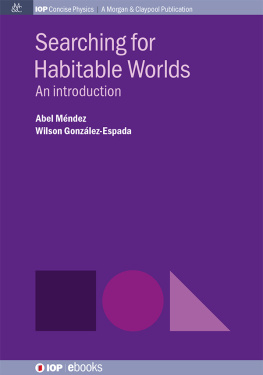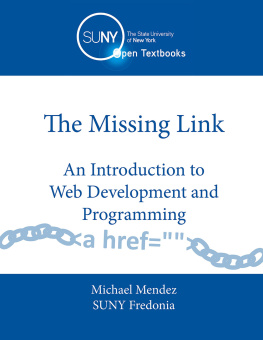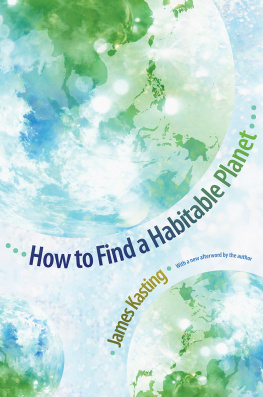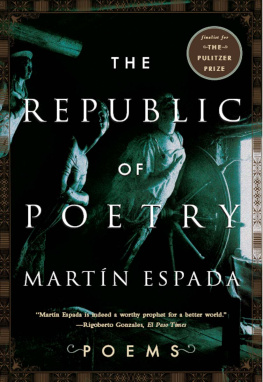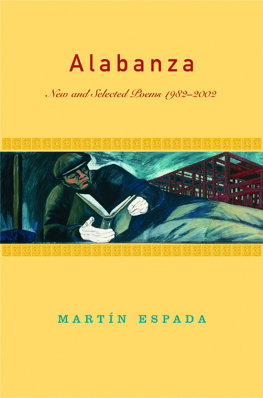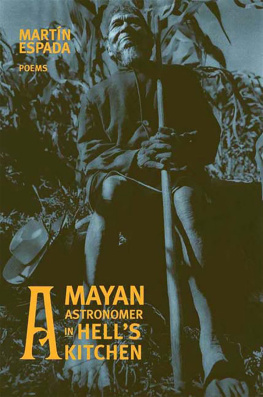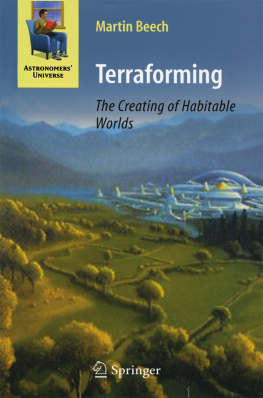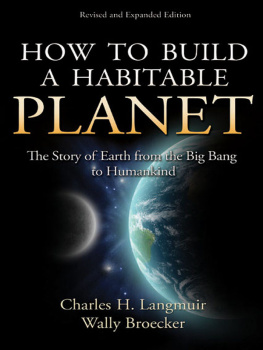Abel Méndez and Wilson González-Espada - Searching for Habitable Worlds: An Introduction
Here you can read online Abel Méndez and Wilson González-Espada - Searching for Habitable Worlds: An Introduction full text of the book (entire story) in english for free. Download pdf and epub, get meaning, cover and reviews about this ebook. year: 2016, publisher: Morgan & Claypool Publishers, genre: Children. Description of the work, (preface) as well as reviews are available. Best literature library LitArk.com created for fans of good reading and offers a wide selection of genres:
Romance novel
Science fiction
Adventure
Detective
Science
History
Home and family
Prose
Art
Politics
Computer
Non-fiction
Religion
Business
Children
Humor
Choose a favorite category and find really read worthwhile books. Enjoy immersion in the world of imagination, feel the emotions of the characters or learn something new for yourself, make an fascinating discovery.
- Book:Searching for Habitable Worlds: An Introduction
- Author:
- Publisher:Morgan & Claypool Publishers
- Genre:
- Year:2016
- Rating:3 / 5
- Favourites:Add to favourites
- Your mark:
- 60
- 1
- 2
- 3
- 4
- 5
Searching for Habitable Worlds: An Introduction: summary, description and annotation
We offer to read an annotation, description, summary or preface (depends on what the author of the book "Searching for Habitable Worlds: An Introduction" wrote himself). If you haven't found the necessary information about the book — write in the comments, we will try to find it.
Searching for Habitable Worlds: An Introduction — read online for free the complete book (whole text) full work
Below is the text of the book, divided by pages. System saving the place of the last page read, allows you to conveniently read the book "Searching for Habitable Worlds: An Introduction" online for free, without having to search again every time where you left off. Put a bookmark, and you can go to the page where you finished reading at any time.
Font size:
Interval:
Bookmark:

An Introduction
Abel Mndez
Planetary Habitability Laboratory,
University of Puerto Rico at Arecibo, Puerto Rico
Wilson Gonzlez-Espada
Department of Mathematics and Physics,
Morehead State University, Morehead, KY, USA
Morgan & Claypool Publishers
Copyright 2016 Morgan & Claypool Publishers
All rights reserved. No part of this publication may be reproduced, stored in a retrieval system or transmitted in any form or by any means, electronic, mechanical, photocopying, recording or otherwise, without the prior permission of the publisher, or as expressly permitted by law or under terms agreed with the appropriate rights organization. Multiple copying is permitted in accordance with the terms of licences issued by the Copyright Licensing Agency, the Copyright Clearance Centre and other reproduction rights organisations.
Rights & Permissions
To obtain permission to re-use copyrighted material from Morgan & Claypool Publishers, please contact .
ISBN 978-1-6817-4401-8 (ebook)
ISBN 978-1-6817-4400-1 (print)
ISBN 978-1-6817-4403-2 (mobi)
DOI 10.1088/978-1-6817-4401-8
Version: 20160401
IOP Concise Physics
ISSN 2053-2571 (online)
ISSN 2054-7307 (print)
A Morgan & Claypool publication as part of IOP Concise Physics
Published by Morgan & Claypool Publishers, 40 Oak Drive, San Rafael, CA, 94903, USA
IOP Publishing, Temple Circus, Temple Way, Bristol BS1 6HG, UK
To all explorers, we are just a dust particle in the universe, make it count.
The hunger for exploring the unknown and answering natures toughest questions is one of humanitys greatest assets. This process has led to theoretical, experimental and practical discoveries in all areas of science, discoveries that have exponentially expanded our limited human senses.
In astronomy, one of the quests that has tested our technological abilities to the limit is the detection and characterization of exoplanets, planets that orbit stars other than our Sun. This is so because the distances between our Solar System and other similar systems in our own Galaxy are simply stupendous, and to even consider the possibility of exoplanets in other galaxies and galaxy super clusters is mindboggling.
So far, over 2000 exoplanets have been discovered, from Jupiter-like behemoths to rocky bodies not unlike Earth or Mars. Their orbital periods are just as varied, some exoplanets zoom around their orbit in as little as three hours, while others orbit sluggishly, their journey taking centuries for each revolution. Some exoplanets are hotter than Venus or colder than Uranus. Although these celestial bodies are as diverse as snowflakes, astronomers have obtained enough information about their physical parameters to start a classification process, a detailed Periodic Table of Exoplanets.
Intriguingly, a few exoplanets are found at interesting locations within the habitable zone. They are neither scaldingly hot nor frigidly cold; and they are neither too light to lack atmospheres or magnetic fields, nor too heavy that gravity forces become unbearable. These exoplanets could potentially be suitable for life as we know it, or might harbor life forms we have not even conceived of in our wildest dreams. What does it take to consider a planet potentially habitable? If a planet is suitable for life, could life be present? Is life an inevitable result of the laws of science? What are the latest science paradigms and the wildest hypotheses that astronomers are considering regarding potentially habitable worlds?
Searching for Habitable Worlds provides both the general public and astronomy enthusiasts with a richly illustrated synthesis of the most current knowledge regarding the process of finding extrasolar planets, measuring their physical and chemical properties, and evaluating to what extent they might fit habitability parameters. After reading this book, we expect young people to see astronomy as a cool and obtainable career path, full of wonder and ripe for discovery. We expect people to become even more curious about science and how it has changed how we see the natural world.
Most people want to know if we are alone in the Universe. Searching for Habitable Worlds does not have a definitive answer, but will show readers the very first places we should look for life, as we know it.
We would like to thank Dr Jennifer J Birriel, Professor of Physics from Morehead State University, for editing the manuscript and providing insightful suggestions for improvement.
We thank the Department of Mathematics and Physics of Morehead State University and the Center for Research and Creative Endeavors of the University of Puerto Rico at Arecibo for their professional support and providing a supportive academic environment.
We would also like to show our gratitude to our families who lovingly tolerated our long hours away from home, researching and writing the manuscript for this book.
Abel Mndez

Professor Abel Mndez is an Associate Professor of Physics and Director of the Planetary Habitability Laboratory, Department of Physics and Chemistry, University of Puerto Rico at Arecibo, Puerto Rico. He performs research on planetary habitability, exoplanets and astrobiology in general.
Wilson Gonzlez-Espada

Dr Wilson Gonzlez-Espada is an Associate Professor of Physics and Science Education, Department of Mathematics and Physics, Morehead State University, Morehead, KY, USA. His scholarly interests include science communication, the public understanding of science and physics education research.
Before going into detail about what is currently known about potentially habitable worlds, it is important to reflect on why humans are so interested in them in particular, and in space more broadly. In one word, the answer is curiosity.
Curiosity is defined as a compulsion to understand our surroundings, a strong eagerness to learn or understand something, or a quest for knowledge that is driven by the novelty, complexity, comprehensibility and unexpected nature of interesting external stimuli [].
Many organisms have an exploratory curiosity [).
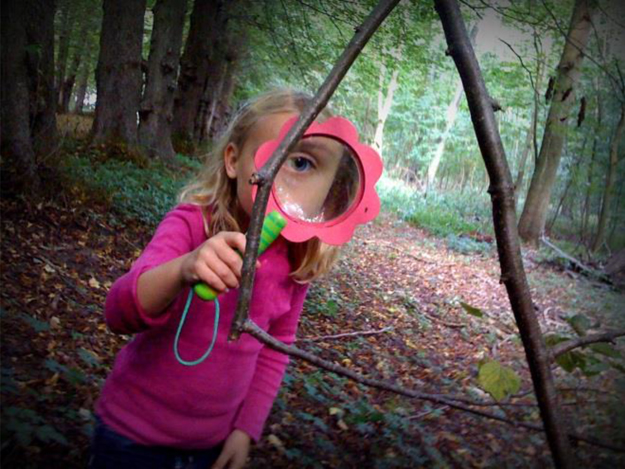
Figure 1.1. Children are born scientists; a childs curiosity is unbridled by preconceptions or expectations. Photo courtesy of Mads Bodker.
There are many examples of the exponential growth of knowledge that is fed through curiosity. One of them was the development of animal collections and plant specimens. What started as cabinets of curiosities in the 17th century grew to become enormous private and public science museums world-wide. Another one was the compilation of scientific information in written form, starting from the science treatises of Ptolemy, Anaximander and Aristotle, and culminating with the terabytes of scientific information stored on the internet and in the cloud. How about the growth and complexity of technology? Ancient Greeks who marveled at the complexity of the Antikythera mechanism (figure ) would be mesmerized by todays manufacturing, communications, medical and space technologies.
Font size:
Interval:
Bookmark:
Similar books «Searching for Habitable Worlds: An Introduction»
Look at similar books to Searching for Habitable Worlds: An Introduction. We have selected literature similar in name and meaning in the hope of providing readers with more options to find new, interesting, not yet read works.
Discussion, reviews of the book Searching for Habitable Worlds: An Introduction and just readers' own opinions. Leave your comments, write what you think about the work, its meaning or the main characters. Specify what exactly you liked and what you didn't like, and why you think so.

